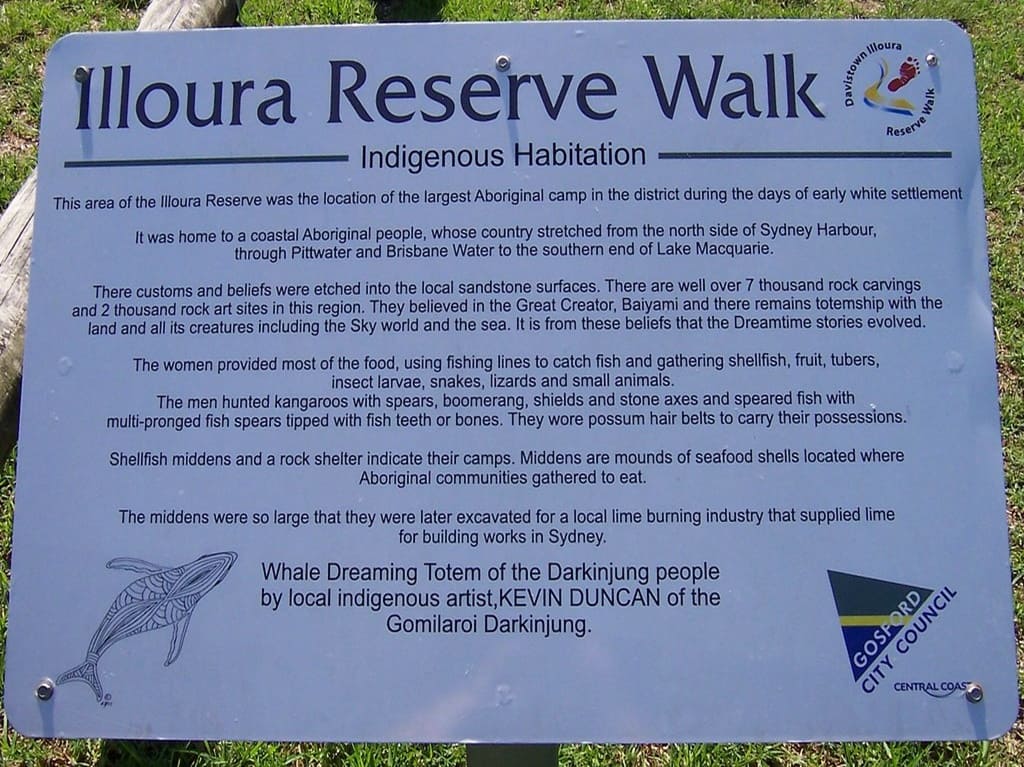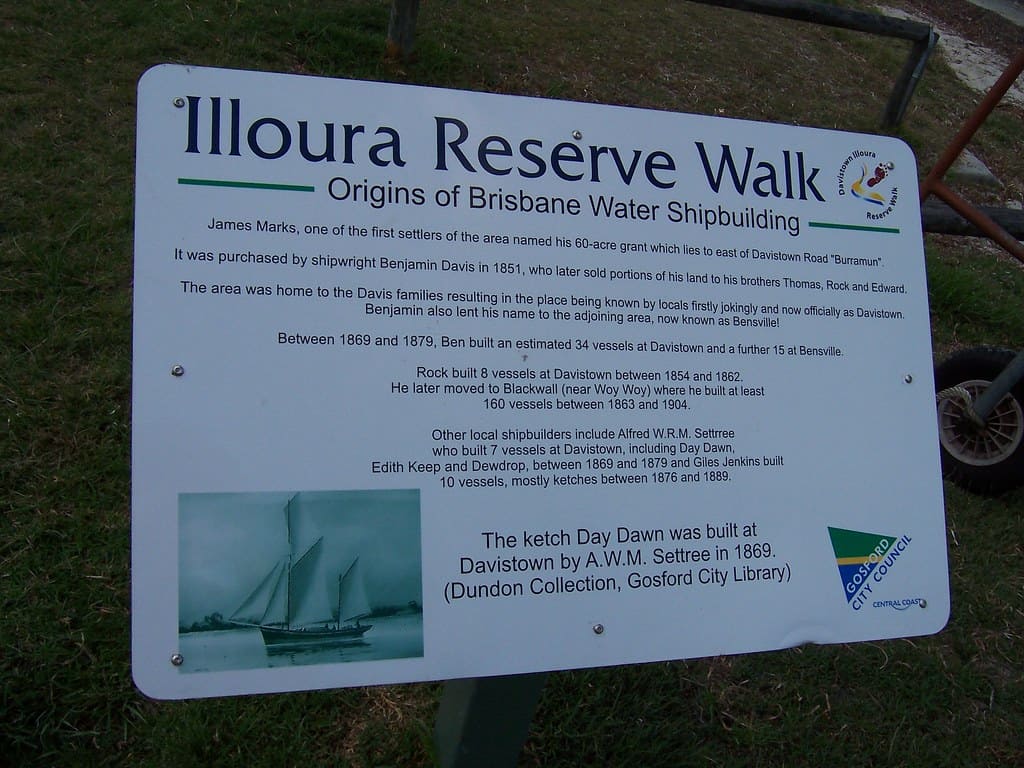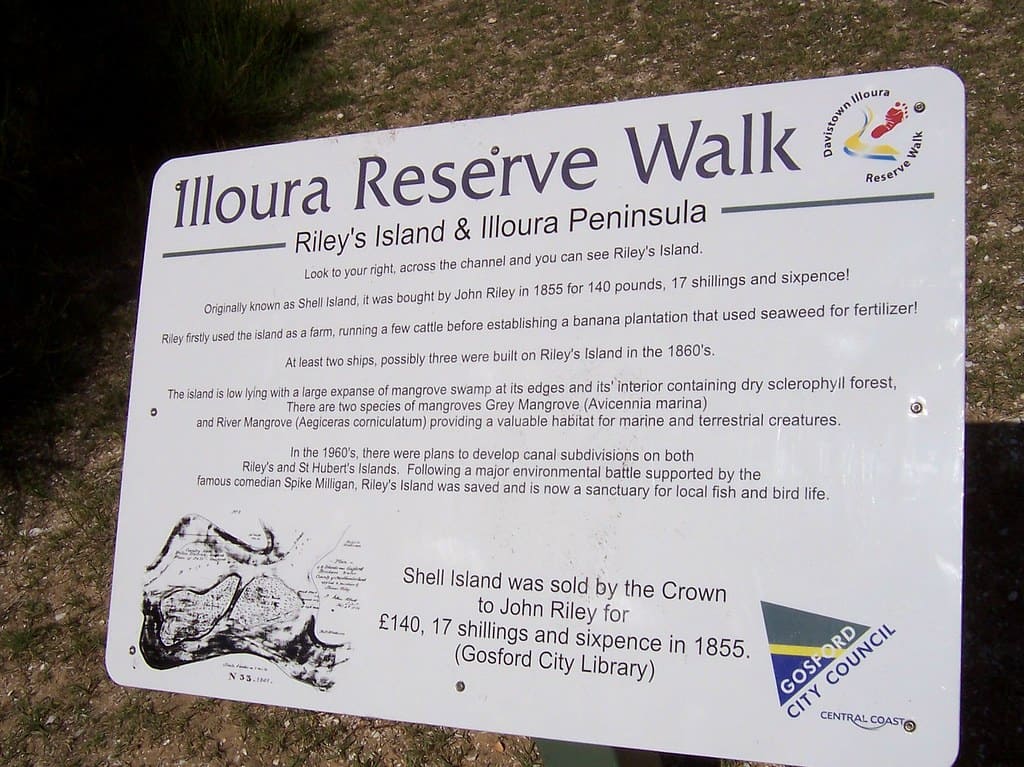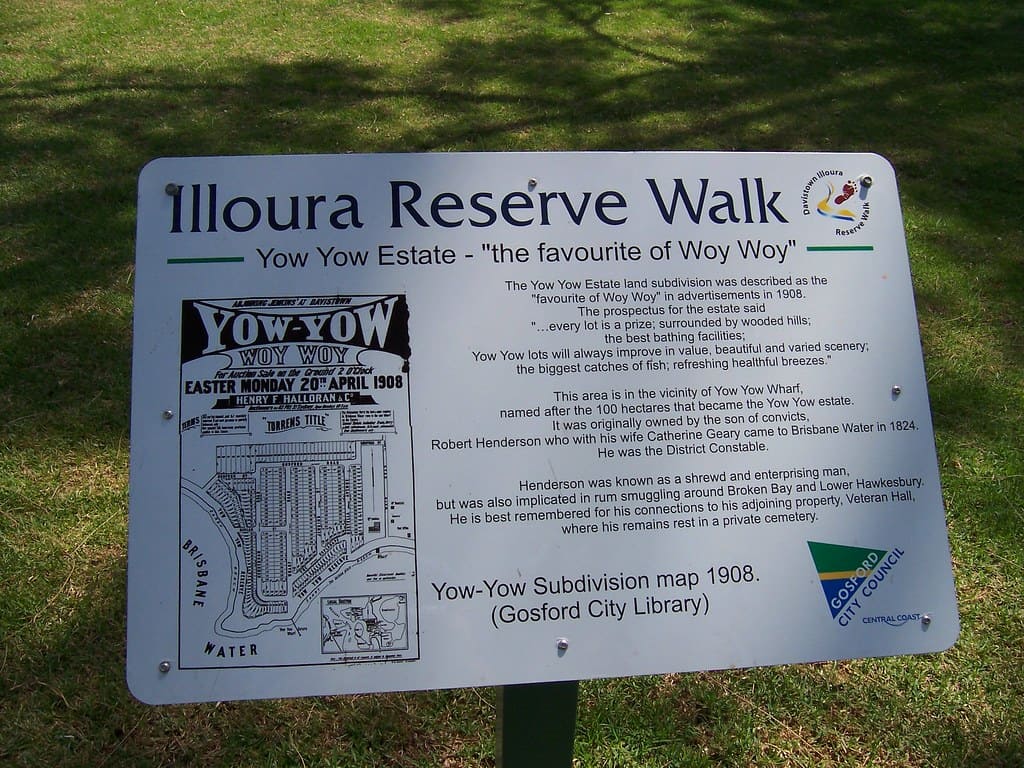Central Coast Ferries
Daily trips, private cruises, high
speed transfers and ferry hire
Discover
_________
Illoura Walk
Davistown Illoura Reserve Walk
_________
Get the Ferry to join the Illoura Walk. Pick up the Central Coast Ferry Service from Woy Woy Wharf.
1st Ferry Stop: Veteran Hall. To reach the Veteran Hall Pioneer Cemetery, walk east along Henderson Road. To rejoin the Illoura Walk proceed another 15 minutes walk (approximately), including a right turn into Malinya Road , then the next right into Pyang Avenue will take you on to the Illoura Reserve. Walk to the left along the reserve and you will come across Lintern Street Wharf.
2nd Ferry Stop: Lintern Street Wharf. This is the beginning of the Illoura walk along the waterfront.
Illoura Reserve Walk Points Of Interest
_________
(Numbers refer to reference numbers on map)
1) Indigenous Habitation
This area of the Illoura Reserve, adjoining the Lintern Street Wharf, was reputed to have been the location of the largest Aboriginal camp in the district during the days of early white settlement. Davistown was home to coastal Aboriginal people, whose country stretched from Sydney Harbour, to Lake Macquarie. Signs of habitation in the Davistown area include a rock shelter and shellfish middens. Evidence of the middens can still be seen on the ground today. The middens were so large that in the years after European settlement, they were excavated to support a lime burning industry supplying the lime for building works in Sydney.
2) Brisbane Water Ferry Services
Before the opening of the Rip Bridge in 1974, the many small communities around Brisbane Water relied heavily on small ferries to get them to Woy Woy and Gosford. Ferries were used for many purposes before reliable road transport; crews and passengers relayed social news around Brisbane Water. Daily newspapers, mail deliveries and produce were regular cargoes. More infrequent cargo included the bodies of deceased persons being taken to Gosford for burial. Every second Thursday the ferries of the district would take shoppers to “Market day” at Gosford.
Pioneer Ferry Service
In 1905 the Sisters of Saint Joseph commenced operating the Pioneer Ferry Service for the patrons and visitors of Kincumber Orphanage, located at Kincumber South. This was the beginning of a regular ferry services on Brisbane Water. The fleet included ferries such as the San Jose, Southern Cross, and Stella Maris, which were well known and loved by holiday makers and locals alike.
Kincumber Growers’ Ferry Service
The Kincumber Growers’ Co-operative Company Ltd formed as the result of a public meeting held in July 1921. Local farmers required a simple and rapid means of getting produce to market and rail transport at Woy Woy. The Growers’ Ferry serviced Davistown, Empire Bay, Woy Woy, Sunnyside (Bensville), Kincumber South and Kincumber Creek. The last Growers’ Ferry Service terminated on 30th June, 1944.
3) Riley’s Island & Illoura Peninsula
Across the channel from the peninsula is Riley’s Island. In 1855 when it was known as Shell Island it was bought by John Riley for 140 pounds, 17 shillings and sixpence. Initially the Riley family farmed and ran a few cattle at Shell Island. Later Riley established a banana plantation, using seaweed for fertiliser. In the 1860s at least two ships, and possibly a third were built on Riley’s Island. To this day John Riley’s descendants still live in the area. Riley’s Island is one of three large islands in Brisbane Water. It is a low-lying island with a large expanse of mangrove swamp around the edges, and dry schlerophyll forest in its’ interior. Mangroves provide valuable habitat for a wide range of marine and terrestrial creatures. Riley’s Island contains two species of mangroves, Avicennia marina (Grey Mangrove) and Aegiceras corniculatum (River Mangrove). However, the recognition of the environmental value of mangrove habitats is a comparatively recent development .
In the 1960’s, there were plans to develop canal subdivisions on both Rileys and St Huberts Islands. Following a major environmental battle supported by the late comedian Spike Milligan, Riley’s Island was saved and is now a sanctuary for local fish and bird life.
4) The Yow Yow Estate
This was in the vicinity of the Yow Yow Wharf. Originally the 100 acres that later became Halloran’s Yow Yow Estate was owned by Robert Henderson, the son of convicts, who was born in 1796 at Parramatta. Henderson, with his wife, came to Brisbane Water in 1824, when he was appointed District Constable. He was by all accounts a shrewd and enterprising man, who was also implicated in rum smuggling around Broken Bay and the Lower Hawkesbury. Robert Henderson is best remembered locally for his connections to his adjoining property Veteran Hall, where a private cemetery contains his remains along with several family members.
5) Exploration by Governor Arthur Phillip
Only five weeks after the arrival of the First Fleet at Sydney Cove, it became clear that reliable supplies of water and food must be found if the settlement was to survive. In early March 1788, Governor Arthur Phillip led a small party of officers and marines on an exploratory voyage along the coast to the north of Sydney Harbour. On this first voyage Phillip passed the site of Davistown, but found little of immediate use to the Sydney Cove settlement. In June 1789, a more thorough investigation of the land was conducted and discounted for agricultural use, owing to the rugged nature of the area. During this voyage, Phillip and his companions explored what we know of today as Brisbane Water, reaching as far as Green Point. An opportunity was taken to investigate the Kincumber Broadwater, and once again Davistown was passed on outward and inward journeys. 3rd Ferry Stop: Central Wharf On Sunday, 29th March 1936, two cars drove down Davistown Road, and plunged off the wharf into Cockle Channel. Six of the eight occupants were drowned. Apparently the driver of the first car mistook the wharf for a bridge. Locals rescued survivors in rowing boats, and they were cared for at Glenorie boarding house.
6) Restella Guest House
While Davistown had its beginnings in the serious business of shipbuilding, by the 1920s it had become a very popular holiday resort. Davistown had much to offer, with regular ferry transport to and from Woy Woy railway station, several well-appointed boarding houses, furnished cottages, boating, fishing and bathing facilities. Horse races were held on a six-furlong racetrack built by Bill and George Davis. The straight of the track is marked by today’s Davis Avenue. In this vicinity stood Restella Guest House, run by local identity Mrs Sarah Ellen Jenkins. The Restella Guest House was noted for its hospitality, with a feeling of home, and a complete lack of formality. A 1928 Tourist guide announced: “there is every provision for all holiday makers’ needs; no one need make a burden of their vacation by dragging up boxes and hampers of provender. Prices locally are very reasonable.”Weekender cottages that were once so plentiful in the area. Made of fibro and timber, many of these buildings were sold as inexpensive kits from local sawmills, or larger suppliers such as George Hudson. You may choose to deviate at this point and walk up Davistown Rd, turning right to visit the Davistown RSL for refreshment, a bite to eat or a game of bowls. You could ring the club on 4369 1291 to call the club bus.
7) Origins of Brisbane Water Shipbuilding
James Marks was one of the first settlers of this area, naming his 60 acre grant, Burramun. In 1851 the shipwright Benjamin Davis purchased Burramun, which lies to the east of today’s Davistown Road. Benjamin subsequently sold portions of his land to his shipwright brothers Thomas, Rock and Edward. The area came to be populated with the Davis’s and their families, hence the name Davistown.
8) Cockle Channel
Messing about in putt-putt boats is an enduring part of the charm of Davistown. Small vintage wooden boats, typically driven by 2 ½ to 10 horsepower engines, can often be seen chugging along Cockle Channel. Beautifully maintained, the putt-putts come together every year in a regatta during October, with activities held on the water and Davistown foreshores. Here, enthusiasts mutter about Chapman Pup’s, Blaxlands and Vincos, and admire boats with names like Cockle Queen and Bal-e-nah. The putt-putts are guaranteed to transport you back to the glory days of Davistown.
9) The Fienberg’s General Store
The local general store was the forerunner of today’s supermarket, and kept communities supplied with a wide range of everyday commodities. The humble General Store was also often a place for exchanging news and gossip, for booking theatre tickets and even buying household insurance. The surviving heritage listed store here has had many owners. In 1928 you could “make your holiday cheaper by getting your goods at “Fienberg’s”,they had “everything you want at city
prices”. Like many General Stores in this area, the owners also rented out furnished cottages for the holiday trade. Continuing along Illoura Reserve there is a playground for children, enclosed swimming area and an amenities block decorated by a mural depicting the history of the locale.





